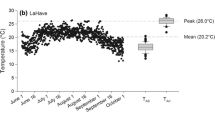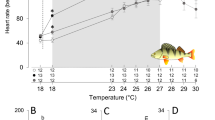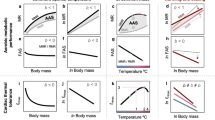Abstract
We tested the hypothesis that cardiorespiratory differences known to exist among adult sockeye salmon populations also exist in the juveniles. To test this hypothesis, we compared cardiac contractility and adrenergic responsiveness of juvenile sockeye salmon from two geographically isolated populations that were reared from eggs under common garden conditions and at two acclimation temperatures (5 °C and 14 °C). However, we found no substantive differences in the force-frequency response (FFR) and the cardiac pumping capacity of juveniles from Weaver Creek and Chilko River populations, even when we considered wild-reared juveniles from one of the populations. An unexpected discovery for all fish groups at 5 °C was a rather flat FFR during tonic β-adrenergic stimulation (βAR) stimulation. Curiously, while active tension nearly doubled with maximum βAR stimulation at low pacing frequencies for all fish groups, a negative FFR with maximum βAR stimulation meant that this inotropic benefit was lost at the highest pacing frequency (0.8 Hz). Active tension with tonic βAR stimulation was similar at 14 °C, but maximum pacing frequency doubled and all fish groups displayed a modest negative FFR. Maximum βAR stimulation again doubled active tension and this benefit was retained even at the highest pacing frequency (1.6 Hz) at 14 °C. Even though subtle population differences were apparent for the FFR and pumping capacity, their biological significance is unclear. What is clear, however, is that the cardiac pumping capacity of juvenile sockeye would benefit more from βAR stimulation swimming at 15 °C than when swimming at 5 °C.





Similar content being viewed by others
Explore related subjects
Discover the latest articles and news from researchers in related subjects, suggested using machine learning.References
Aho E, Vornanen M (1999) Contractile properties of atrial and ventricular myocardium of the heart of rainbow trout Oncorhynchus mykiss: effects of thermal acclimation. J Exp Biol 202:2663–2677
Altimiras J, Larsen E (2000) Non-invasive recording of heart rate and ventilation rate in rainbow trout during rest and swimming. Fish go wireless! J Fish Biol 57:197–209. https://doi.org/10.1006/jfbi.2000.1299
Ask JA (1983) Comparative aspects of adrenergic receptors in the hearts of lower vertebrates. Comp Biochem Physiol Part A Physiol 76:543–552. https://doi.org/10.1016/0300-9629(83)90456-5
Axelsson M (2005) The circulatory system and its control. In: Farrell AP, Steffensen JF (eds) The physiology of polar fishes. Academic Press, Cambridge, pp 239–280
Brannon EL (1972) Mechanisms controlling the migration of sockeye salmon fry. Int Pacific Salmon Fish Comm Bull 21:1–86
Chen Z, Anttila K, Wu J, Whitney CK, Hinch SG, Farrell AP (2013) Optimum and maximum temperatures of sockeye salmon (Oncorhynchus nerka) populations hatched at different temperatures. Can J Zool 91:265–274. https://doi.org/10.1139/cjz-2012-0300
Crossin GT, Hinch SG, Farrell AP, Higgs DA, Lotto AG, Oakes JD, Healey MC (2004) Energetics and morphology of sockeye salmon: effects of upriver migratory distance and elevation. J Fish Biol 65:788–810. https://doi.org/10.1111/j.0022-1112.2004.00486.x
Crossin GT, Hinch SG, Cooke SJ, Welch DW, Batten SD, Patterson DA, Van Der Kraak G, Shrimpton JM, Farrell AP (2007) Behaviour and physiology of sockeye salmon homing through coastal waters to a natal river. Mar Biol 152:905–918. https://doi.org/10.1007/s00227-007-0741-x
Driedzic WR, Gesser H (1985) Ca2 + protection from the negative inotropic effect of contraction frequency on teleost hearts. J Comp Physiol B 156:135–142. https://doi.org/10.1007/BF00692936
Driedzic WR, Gesser H (1988) Differences in force-frequency relationships and calcium dependency between elasmobranch and teleost hearts. J Exp Biol 140:227–241
Driedzic WR, Gesser H (1994) Energy metabolism and contractility in ectothermic vertebrate hearts: hypoxia, acidosis, and low temperature. Physiol Rev 74:221–258
Ekström A, Hellgren K, Gräns A, Pichaud N, Sandblom E (2016) Dynamic changes in scope for heart rate and cardiac autonomic control during warm acclimation in rainbow trout. J Exp Biol 219:1106–1109. https://doi.org/10.1242/jeb.134312
Eliason EJ, Anttila K (2017) Temperature and the cardiovascular system. In: Gamperl AK, Gillis TE, Farrell AP, Brauner CJ (eds) Fish physiology. Academic Press, Cambridge, pp 235–297
Eliason EJ, Clark TD, Hague MJ, Hanson LM, Gallagher ZS, Jeffries KM, Gale MK, Patterson DA, Hinch SG, Farrell AP (2011) Differences in thermal tolerance among sockeye salmon populations. Science 332:109–112. https://doi.org/10.1126/science.1199158
Eliason EJ, Clark TD, Hinch SG, Farrell AP (2013a) Cardiorespiratory performance and blood chemistry during swimming and recovery in three populations of elite swimmers: adult sockeye salmon. Comp Biochem Physiol A Mol Integr Physiol 166:385–397. https://doi.org/10.1016/j.cbpa.2013.07.020
Eliason EJ, Clark TD, Hinch SG, Farrell AP (2013b) Cardiorespiratory collapse at high temperature in swimming adult sockeye salmon. Conserv Physiol 1:1–19. https://doi.org/10.1093/conphys/cot008
Eliason EJ, Wilson SM, Farrell AP, Cooke SJ, Hinch SG (2013c) Low cardiac and aerobic scope in a coastal population of sockeye salmon Oncorhynchus nerka with a short upriver migration. J Fish Biol 82:2104–2112. https://doi.org/10.1111/jfb.12120
Eliason EJ, Gale MK, Whitney CK, Lotto A, Hinch SG (2017) Intraspecific differences in endurance swim performance and cardiac size in sockeye salmon (Oncorhynchus nerka) parr tested at three temperatures. Can J Zool 95:425–432. https://doi.org/10.1139/cjz-2016-0248
Farrell AP (2016) Pragmatic perspective on aerobic scope: peaking, plummeting, pejus and apportioning. J Fish Biol 88:322–343. https://doi.org/10.1111/jfb.12789
Farrell AP, Smith F (2017) Cardiac form, function and physiology. In: Gamperl AK, Gillis TE, Farrell AP, Brauner CJ (eds) Fish physiology, 1st edn. Elsevier Inc., Amsterdam, pp 155–264
Farrell AP, MacLeod KR, Chancey B (1986) Intrinsic mechanical properties of the perfused rainbow trout heart and the effects of catecholamines and extracellular calcium under control and acidotic conditions. J Exp Biol 125:319–345
Farrell AP, Gamperl AK, Hicks JMT, Shiels HA, Jain KE (1996) Maximum cardiac performance of rainbow trout (Oncorhynchus mykiss) at temperatures approaching their upper lethal limit. J Exp Biol 199:663–672
Gallaugher P, Thorarensen H, Farrell AP (1995) Hematocrit in oxygen transport and swimming in rainbow trout (Oncorhynchus mykiss). Respir Physiol 102:279–292. https://doi.org/10.1016/0034-5687(95)00065-8
Gamperl AK, Farrell AP (2004) Cardiac plasticity in fishes: environmental influences and intraspecific differences. J Exp Biol 207:2539–2550. https://doi.org/10.1242/jeb.01057
Gamperl AK, Vijayan MM, Pereira C, Farrell AP (1998) β-Receptors and stress protein 70 expression in hypoxic myocardium of rainbow trout and chinook salmon. Am J Physiol Integr Comp Physiol 274:R428–R436. https://doi.org/10.1152/ajpregu.1998.274.2.R428
Gesser H (1977) The effects of hypoxia and reoxygenation on force development in myocardia of carp and rainbow trout: protective effects of CO2/HCO3. J Exp Biol 69:199–206
Goodlad JC, Gjernes TW, Brannon EL (1974) Factors affecting sockeye salmon (Oncorhynchus nerka) growth in four lakes of the Fraser River system. Fish Res Board Canada 31:871–892
Goulding AT, Farrell AP (2016) Quantification of ventricular β2-adrenoceptor density and ligand binding affinity in wild sockeye salmon Oncorhynchus nerka smolts using a novel modification to the tritiated ligand technique. J Fish Biol 88:2081–2087. https://doi.org/10.1111/jfb.12977
Graham MS, Farrell AP (1989) The effect of temperature acclimation and adrenaline on the performance of a perfused trout heart. Physiol Zool 62:38–61. https://doi.org/10.1086/physzool.62.1.30159997
Hanson LM, Farrell AP (2007) The hypoxic threshold for maximum cardiac performance in rainbow trout Oncorhynchus mykiss (Walbaum) during simulated exercise conditions at 18° C. J Fish Biol 71:926–932. https://doi.org/10.1111/j.1095-8649.2007.01533.x
Hanson LM, Ip YK, Farrell AP (2005) The effect of temperature acclimation on myocardial β-adrenoceptor density and ligand binding affinity in African catfish (Claris gariepinus). Comp Biochem Physiol A Mol Integr Physiol 141:164–168. https://doi.org/10.1016/j.cbpb.2005.04.018
Hanson LM, Obradovich S, Mouniargi J, Farrell AP (2006) The role of adrenergic stimulation in maintaining maximum cardiac performance in rainbow trout (Oncorhynchus mykiss) during hypoxia, hyperkalemia and acidosis at 10 °C. J Exp Biol 209:2442–2451. https://doi.org/10.1242/jeb.02237
Hartman W, Heard W, Drucker B (1967) Migratory behavior of sockeye salmon fry and smolts. J Fish Res Board Can 24:2069–2099. https://doi.org/10.1139/f67-171
Hartmund T, Gesser H (1996) Cardiac force and high-energy phosphates under metabolic inhibition in four ectothermic vertebrates. Am J Physiol Integr Comp Physiol 271:R946–R954. https://doi.org/10.1152/ajpregu.1996.271.4.R946
Hume JMB, Shortreed KS, Morton KF (1996) Juvenile sockeye rearing capacity of three lakes in the Fraser River system. Can J Fish Aquat Sci 53:719–733. https://doi.org/10.1139/f95-237
Joyce W, Simonsen M, Gesser H, Wang T (2016) The effects of hypoxic bradycardia and extracellular HCO3-/CO2 on hypoxic performance in the eel heart. J Exp Biol 219:302–305. https://doi.org/10.1242/jeb.130971
Keen JE, Vianzon DM, Farrell AP, Tibbits GF (1993) Thermal acclimation alters both adrenergic sensitivity and adrenoceptor density in cardiac tissue of rainbow trout. J Exp Biol 181:27–47
Larsen J, Bushnell P, Steffensen J, Pedersen M, Qvortrup K, Brill R (2017) Characterization of the functional and anatomical differences in the atrial and ventricular myocardium from three species of elasmobranch fishes: smooth dogfish (Mustelus canis), sandbar shark (Carcharhinus plumbeus), and clearnose skate (Raja eglanteria). J Comp Physiol B Biochem Syst Environ Physiol 187:291–313. https://doi.org/10.1007/s00360-016-1034-9
Layland J, Young IS, Altringham JD (1995) The effect of cycle frequency on the power output of rat papillary muscles in vitro. J Exp Biol Biol 198:1035–1043
Lefrançois C, Claireaux G (2003) Influence of ambient oxygenation and temperature on metabolic scope and scope for heart rate in the common sole Solea solea. Mar Ecol Prog Ser 259:273–284. https://doi.org/10.3354/meps259273
Mathes MT, Hinch SG, Cooke SJ, Crossin GT, Patterson A, Lotto AG, Farrell AP (2009) Effect of water temperature, timing, physiological condition, and lake thermal refugia on migrating adult Weaver Creek sockeye salmon (Oncorhynchus nerka). Can J Fish Aquat Sci 67:70–84. https://doi.org/10.1139/F09-158
Matikainen BYN, Vornanen M (1992) Effect of season and temperature acclimation on the function of Crucian carp (Carassius carassius) heart. J Exp Biol 167:203–220
Mercier C, Axelsson M, Imbert N, Claireaux G, Lefrançois C, Altimiras J, Farrell AP (2002) In vitro cardiac performance in triploid brown trout at two acclimation temperatures. J Fish Biol 60:117–133. https://doi.org/10.1006/jfbi.2001.1815
Methling C, Steffensen JF, Skov PV (2012) The temperature challenges on cardiac performance in winter-quiescent and migration-stage eels Anguilla anguilla. Comp Biochem Physiol A Mol Integr Physiol 163:66–73. https://doi.org/10.1016/j.cbpa.2012.05.183
Milligan CL, Graham MS, Farrell AP (1989) The response of trout red cells to adrenaline during seasonal acclimation and changes in temperature. J Fish Biol 35:229–236. https://doi.org/10.1111/j.1095-8649.1989.tb02972.x
Nilsson S (1983) Autonomic nerve function in the vertebrates. Springer, Berlin Heidelberg
Overgaard J, Gesser H (2004) Force development, energy state and ATP production of cardiac muscle from turtles and trout during normoxia and severe hypoxia. J Exp Biol 207:1915–1924. https://doi.org/10.1242/jeb.00975
Overgaard J, Stecyk JAW, Gesser H, Wang T, Farrell AP (2004) Effects of temperature and anoxia upon the performance of in situ perfused trout hearts. J Exp Biol 207:655–665. https://doi.org/10.1242/jeb.00791
Priede IG (1974) The effect of swimming activity and section of the vagus nerves on heart rate in rainbow trout. J Exp Biol 60:305–319
Quinn TP (2018) Behavior and ecology of the Pacific salmon and trout. University of Washington Press, Seattle
Randall DJ (1968) Functional morphology of the heart in fishes. Am Zool 8:179–189. https://doi.org/10.1093/icb/8.2.179
Sandblom E, Axelsson M (2011) Autonomic control of circulation in fish: a comparative view. Auton Neurosci 165:127–139. https://doi.org/10.1016/j.autneu.2011.08.006
Shiels HA, Farrell AP (1997) The effect of temperature and adrenaline on the relative importance of the sarcoplasmic reticulum in contributing Ca2 + to force development in isolated ventricular trabeculae from rainbow trout. J Exp Biol 200:1607–1621
Shiels HA, Farrell AP (2000) The effect of ryanodine on isometric tension development in isolated ventricular trabeculae from Pacific mackerel (Scomber japonicus). Comp Biochem Physiol A Mol Integr Physiol 125:331–341. https://doi.org/10.1016/S1095-6433(00)00161-6
Shiels H, Stevens E, Farrell A (1998) Effects of temperature, adrenaline and ryanodine on power production in rainbow trout Oncorhynchus mykiss ventricular trabeculae. J Exp Biol 201(19):2701–2710
Shiels HA, Vornanen M, Farrell AP (2002) The force–frequency relationship in fish hearts—a review. Comp Biochem Physiol Part A Mol Integr Physiol 132:811–826. https://doi.org/10.1016/S1095-6433(02)00050-8
Shortreed KS, Morton KF, Malange K, Hume JMB (2001) Factors limiting juvenile sockeye production and enhancement potential for selected BC nursery lakes. Can Sci Advis Secr 2001(98):69
Shrimpton JM, Patterson DA, Richards JG, Cooke SJ, Schulte PM, Hinch SG, Farrell AP (2005) Ionoregulatory changes in different populations of maturing sockeye salmon Oncorhynchus nerka during ocean and river migration. J Exp Biol 208:4069–4078. https://doi.org/10.1242/jeb.01871
Skov PV, Bushnell PG, Tirsgaard B, Steffensen JF (2009) The role of adrenaline as a modulator of cardiac performance in two Antarctic fishes. Polar Biol 32:215–223. https://doi.org/10.1007/s00300-008-0522-0
Sopinka NM, Hinch SG, Lotto AG, Whitney CK, Patterson DA (2013) Does among-population variation in burst swimming performance of sockeye salmon Oncorhynchus nerka fry reflect early life migrations? J Fish Biol 83:1416–1424. https://doi.org/10.1111/jfb.12225
Steinhausen MF, Sandblom E, Eliason EJ, Verhille C, Farrell AP (2008) The effect of acute temperature increases on the cardiorespiratory performance of resting and swimming sockeye salmon (Oncorhynchus nerka). J Exp Biol 211:3915–3926. https://doi.org/10.1242/jeb.019281
Vornanen M (1989) Regulation of contractility of the fish (Carassius carassius L.) heart ventricle. Comp Biochem Physiol Part C Comp Pharmacol 94:477–483. https://doi.org/10.1016/0742-8413(89)90101-1
Vornanen M (2017) Electrical excitability of the fish heart and its autonomic regulation. In: Gamperl AK, Gillis TE, Farrell AP, Brauner CJ (eds) Fish physiology. Academic Press, Cambridge, pp 99–153
Whitney CK, Hinch SG, Patterson DA (2013) Provenance matters: thermal reaction norms for embryo survival among sockeye salmon Oncorhynchus nerka populations. J Fish Biol 82:1159–1176. https://doi.org/10.1111/jfb.1205
Acknowledgements
The authors thank A. G. Lotto and N. B. Furey for assistance in the field, S. G. Hinch for logistical advice and support, and R. Brill for kindly providing a custom Matlab script and help with its use. Additional assistance in the laboratory by K. Aminov, N. Serbedzija, and H. Safi was greatly appreciated and we extend our gratitude to the Department of Fisheries and Oceans (DFO) Stock Assessment group at the Chilko field camp for the help they provided. Furthermore, we thank the Xeni Gwet’in First Nation for access to the study site and DFO for the field site accommodations.
Funding
Funding was provided by the Pacific Salmon Foundation, Canada Ocean Tracking Network [National Sciences and Engineering Research Council (NSERC) and the Canadian Foundation for Innovation] and in the form of NSERC Discovery Grants to A. P. Farrell. and S. G. Hinch. A. P. Farrell is supported by the Canada Research Chair (Tier I) program.
Author information
Authors and Affiliations
Contributions
All authors contributed to the study conception and design. Material preparation, data collection and analysis were performed by Adam Goulding. Adam Goulding and Anthony Farrell drafted and finalized the manuscript.
Corresponding author
Additional information
Communicated by Bernd Pelster.
Publisher's Note
Springer Nature remains neutral with regard to jurisdictional claims in published maps and institutional affiliations.
Rights and permissions
About this article
Cite this article
Goulding, A.T., Farrell, A.P. The effect of temperature acclimation on the force-frequency relationship and adrenergic sensitivity of the ventricle of two populations of juvenile sockeye salmon. J Comp Physiol B 190, 717–730 (2020). https://doi.org/10.1007/s00360-020-01299-w
Received:
Revised:
Accepted:
Published:
Issue Date:
DOI: https://doi.org/10.1007/s00360-020-01299-w




